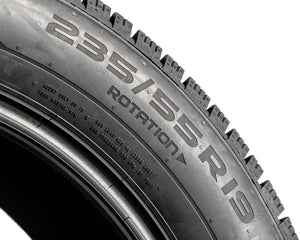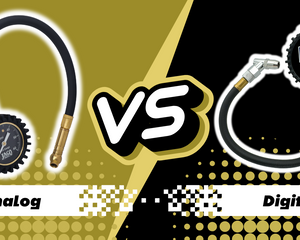
Few experiences compare to the thrill and exhilaration of off-roading. For those unfamiliar, off-roading is the activity of driving or riding a vehicle on unsurfaced terrains such as sand, gravel, riverbeds, mud, snow, rocks, and other natural environments. It's an adventure that pushes both driver and machine to their limits, testing their ability to navigate and overcome challenging landscapes that are far removed from the predictability of paved roads.
But as any seasoned off-roader knows, the key to a successful and safe journey doesn't just lie in a robust vehicle or advanced driving skills. It also comes down to something as essential as tire pressure. Yes, the amount of air in your tires plays a critical role when you're off-roading.
Tire pressure is more than just a number—it directly influences your vehicle's performance, handling, and safety, especially in off-road conditions. It affects how your tires spread out on the terrain, their grip, and even their resilience against punctures and damage. It’s the unsung hero of your off-road adventures, silently working to ensure that your ride remains stable and your tires intact, regardless of the challenges the wild throws at you.
This guide aims to highlight the importance of tire pressure in off-roading and provide a comprehensive understanding of how you can optimize it for a safer and more enjoyable off-road experience. So, strap in and prepare for a deep dive into the world of off-roading tire pressure.

Understanding Tire Pressure: The Basics
Before we venture further into off-roading specifics, it's crucial to comprehend what tire pressure is and why it's essential. Tire pressure refers to the amount of air filled in your tires, typically measured in pounds per square inch (PSI) or bar in some regions. This isn't just air filling a space; it's what supports your vehicle, impacting how your tires meet the road or, in our case, the off-road terrain.
When it comes to tire pressure, a delicate balance is key. Both overinflation and underinflation can lead to compromised vehicle performance and safety issues.
Overinflation, or having too much air in your tires, can reduce the amount of tire tread connecting with the ground, known as the 'contact patch.' This reduction can negatively impact your vehicle's traction, handling, and braking, especially on rugged off-road terrains. Furthermore, overinflated tires are more vulnerable to damage from sharp rocks or other obstacles because they are less able to absorb shocks.
On the other hand, underinflation — too little air in your tires — has its own set of problems. Underinflated tires have a larger contact patch, which can cause tires to overheat due to increased friction, potentially leading to tire failure. Moreover, low tire pressure increases the risk of tire damage, as the tires are less capable of protecting the rims from impact with rocks or other obstacles.
The influence of tire pressure on vehicle performance and safety is significant and can't be overlooked. It's an integral part of vehicle maintenance and becomes even more critical when you're navigating unpredictable and challenging off-road terrains. Understanding and regularly checking your tire pressure ensures that you are well-prepared for any off-roading adventure and can confidently tackle any terrain while minimizing the risk of tire damage or failure.

The Role of Tire Pressure in Off-Roading
Let's get into the nitty-gritty of off-roading and understand why tire pressure plays such a pivotal role in this thrilling activity. Off-roading is not just about horsepower and torque; it's about how effectively your vehicle can utilize that power. Tire pressure, among other things, can significantly influence your vehicle's performance on rugged terrains.
In an off-road scenario, the tire pressure you choose can influence your vehicle's traction and control in numerous ways. Properly adjusted tire pressure can improve grip, provide better flotation over soft ground, and offer protection against punctures and rim damage.
How Tire Pressure Impacts Off-road Performance
When off-roading, reducing tire pressure is a common practice. Lowering the tire pressure increases the tire's footprint or contact patch, the part of the tire that makes contact with the ground. This expansion results in improved traction and more excellent stability, enabling your vehicle to traverse challenging terrains more effectively. Additionally, the softer, lower pressure tires can absorb more shocks from the uneven ground, providing a more comfortable ride.
However, it's important to remember that the correct tire pressure varies with different conditions. You'll need a higher pressure for rocky terrains to prevent punctures and rim damage, while sand or mud might require lower pressure for better flotation.
The Effect of Tire Pressure on Traction and Control in Off-Road Conditions
When it comes to traction on off-road surfaces, tire pressure plays a vital role. Lower pressure allows more tire tread to grip the surface, increasing traction and control. This increased traction is especially beneficial when climbing steep slopes or traversing slippery terrains where maintaining control can be a challenge.
Simultaneously, lower pressure helps tires deform and adapt to the terrain, effectively "gripping" rocks, logs, or other obstacles, which can enhance your vehicle's climbing abilities. However, excessively low pressure can lead to problems like tire bead dislocation or sidewall damage, so it's vital to find the right balance.

Correct Tire Pressure for Off-Roading
Navigating your way through off-road adventures requires the right tire pressure. Here, we delve into some general guidelines, the various factors affecting the ideal off-road tire pressure, and tips to determine the best tire pressure for your specific needs.
General Guidelines for Off-Road Tire Pressure
While the precise tire pressure depends on numerous factors, here are some broad recommendations. For light off-roading on mainly hard-packed surfaces, you can reduce your tire pressure to approximately 20-25 psi. For more challenging terrains like deep sand or mud, dropping it further to 15-20 psi can increase traction. On particularly rugged terrains with rocks or sharp objects, stick closer to 25-30 psi to prevent punctures.
Keep in mind that these are only general guidelines. Always adjust based on your specific circumstances and remember never to go too low. Extremely low tire pressure could result in the tire separating from the rim.
Factors Affecting Ideal Off-Road Tire Pressure
Several variables can affect the ideal tire pressure for off-roading, including:
- Vehicle Weight: Heavier vehicles require higher tire pressure than lighter ones to adequately support the weight.
- Tire Size and Type: Larger tires can typically run at lower pressures, while certain types of off-road tires are designed to function best at specific pressure ranges.
- Terrain: Softer terrains like sand or mud typically require lower pressures for better flotation. Conversely, rocky or rough terrains require higher pressures to protect against punctures and rim damage.
- Driving Speed: If you're traveling at higher speeds, you'll need more pressure to prevent damage and maintain control.
How to Determine the Best Tire Pressure for Your Off-Road Adventure
Identifying the best tire pressure for your off-road expedition involves considering the above factors in relation to your specific situation. Start with the recommended tire pressure for your vehicle and tires, then adjust based on the terrain and your vehicle's load.
Remember, finding the perfect tire pressure might involve some trial and error. Consider investing in a high-quality tire pressure gauge and tire deflator. These tools will help you adjust your tire pressure accurately and swiftly, even while you're out on the trails.
As you gain more experience, you'll develop a feel for the right tire pressures for different situations. Until then, it's better to err on the side of caution and not deflate too much. Safety should always be your priority!

How to Adjust Your Tire Pressure for Off-Roading
Getting the right tire pressure can make or break your off-roading experience. Let's go over the steps to properly inflate and deflate your tires, and discuss the significance of owning a high-quality tire pressure gauge.
Step-by-step Guide on How to Properly Inflate and Deflate Tires for Off-Roading:
Step 1: Start with the Right Pressure
Begin your journey with your tires inflated to the manufacturer's recommended tire pressure. This information can usually be found in your vehicle's owner's manual or on the placard on the driver's side door jamb.
Step 2: Assess the Terrain
Once you reach the off-road area, assess the terrain. If it's rocky or uneven, you might need to deflate your tires to increase the tire's footprint and improve traction.
Step 3: Deflate Your Tires
To deflate your tires, remove the valve cap and use a tire deflator or a tire gauge with a built-in bleeder valve. Keep a close eye on your tire pressure gauge to ensure you don't deflate too much. Remember, it's easier to let out more air later if necessary than to add it back in out on the trail.
Step 4: Check the Pressure
After deflating, use your tire pressure gauge to check the pressure in each tire. Ensure all tires have even pressure for balanced driving.
Step 5: Re-Inflate Post Adventure
Once you're back on the pavement, it's time to re-inflate your tires to the manufacturer's recommended pressure. Having a portable air compressor in your vehicle makes this step a breeze.
Importance of Having a High-Quality Tire Pressure Gauge
A high-quality tire pressure gauge is a crucial tool for any off-road enthusiast. Accurate tire pressure readings are essential for safe and effective off-roading. A small discrepancy can significantly impact your vehicle's performance and safety.
Moreover, a well-built gauge will withstand the harsh conditions of off-roading and provide reliable readings time after time. Some gauges even come with built-in deflators, making it even easier to adjust your tire pressure on the go.

Recommendations for Best Tire Pressure Gauges for Off-Roading
Your off-roading kit isn't complete without a reliable tire pressure gauge. It's not just about maintaining optimal tire pressure; it's about ensuring your safety and enhancing your vehicle's performance on rugged terrains. So, let's delve into some of the best tire pressure gauges for off-roading, particularly focusing on a few models from JACO that have won the trust of many off-roading enthusiasts.
1. JACO Elite Digital Tire Pressure Gauge - 100 PSI
If you're looking for accuracy combined with ease of use, this digital tire pressure gauge is an excellent choice. It provides quick, precise readings up to 100 PSI, illuminates in the dark, and its rugged design withstands the tough off-road conditions. Whether you have a 4x4, SUV, or an ATV, this gauge is up to the task.
2. JACO ElitePro Tire Pressure Gauge - 60 PSI
This model combines the durability of a mechanical gauge with pinpoint accuracy. With a solid brass body and a rugged gear-style protective guard, it's built to last. Its 60 PSI range is perfect for most off-road vehicles, and the 2-inch glow dial ensures you can take readings even in low light conditions.
3. JACO Elite Low Pressure Tire Gauge - 30 PSI
For those off-roading activities where lower tire pressures are required, this model is a gem. It gives precise low-pressure readings, which is essential for optimizing traction on loose surfaces like sand or mud. Its robust construction and the easy-to-read 2" dial make it a convenient and reliable tool to have during your off-road adventures.
Remember, a quality tire pressure gauge is a small investment towards safer and more enjoyable off-roading experiences. Choose one that suits your needs and your vehicle's specifications.
Final Thoughts
Off-roading is a thrilling journey that leads you through uncharted terrains and landscapes. However, the excitement and fun come with the responsibility of ensuring a safe ride. One key factor that significantly contributes to a safe and smooth off-roading experience is maintaining the right tire pressure.
Throughout this guide, we've delved into the concept of tire pressure, its impact on vehicle performance, especially in off-road conditions, and the importance of adjusting your tire pressure to match your off-road adventure. The process may seem a bit complex initially, but with a good understanding and the right tools, it becomes second nature.
Remember, your vehicle's tire pressure is not a set-and-forget aspect; it demands regular monitoring and adjustment based on various factors like terrain and load. A quality tire pressure gauge, like the ones from JACO, can be your best companion in ensuring you always stay within the optimal pressure range.
In conclusion, tire pressure plays a pivotal role in shaping your off-roading experience. Keeping a close eye on it ensures not only your safety but also the longevity of your tires and vehicle performance. So, before you set off on your next off-road trip, make sure to check your tire pressure.
Here's to safe and thrilling off-roading adventures!







